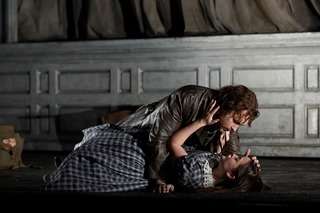|
Back
Spookily effective Toronto
The Four Seasons Centre for the Performing Arts
04/17/2013 - & April 20, 26, 30, May 9, 12, 15, 18, 24, 2013
Gaetano Donizetti: Lucia di Lammermoor
Anna Christy (Lucia), Stephen Costelo (Edgardo), Brian Mulligan (Enrico), Oren Gradus (Raimondo), Nathaniel Peake (Arturo), Sasha Djihanian (Alisa), Adam Luther (Normanno)
The Canadian Opera Company Chorus, Sandra Horst (Chorus Master), The Canadian Opera Company Orchestra, Stephen Lord (Conductor)
David Alden (Director), Charles Edwards (Set Designer), Brigitte Rieffenstuel (Costume Designer), Adam Silverman (Lighting Designer), Claire Glaskin (Choreographer)

S. Costello, A. Christy (© Michael Cooper)
Opening night for this production was greeted with cheers for the singers and conductor then polite applause mixed with a few jeers for the production team. (Remember: the audience is always right.)
David Alden (whose only other production for the COC was Die Entführung aus dem Serail back in 1980) has set the work in a decrepit house (his notes tell us it’s an insane asylum) in the 19th century. Sets and costumes are black, white and grey which serves to set off the blood when it is finally revealed. Because of the drab sets the lighting, which manages to be both stark and gloomy, is more than usually crucial in supporting the overriding sense of menace and oppression.
Large Victorian portrait photographs are a central part of many scenes, and a central aim of the production seems to be to establish tableau vivants at crucial moments. This requires a good deal of furniture shifting during the stage action; for example, during the sextet, Lucia is ever so gradually manoeuvred into fainting on top of a table; getting there is awkward but the resulting tableau is a memorable moment. Later on, in the opera’s most famous scene, we end up with what could be called “Group Portrait with Mad Woman” - very effective.
Anna Christy has been the Lucia in this production from the beginning when it was presented at ENO in 2008, then repeated in 2010. It’s no surprise that the production fits her like a glove. She is a petite, doll-like woman; her costumes seem inspired by John Tenniel’s illustrations of Alice and her oversize wedding gown makes her look like a child playing dress up. She doesn’t deliver an industrial strength, world-striding Lucia (which would be inappropriate here anyway) but a vulnerable girl. Just for the record, she has all the requisite landmark notes.
Stephen Costello gives ample evidence as to why his star has been rising. His all-out vocalism still has lots of room for nuance of expression.
Brian Mulligan portrays the vengeful brother, Enrico, with a vocal ferocity sometimes at odds with Donizetti’s bel canto style. In his initial aria he proclaims Cruda, funesta smania (“Raw, deadly desire”) which we soon find out is a hatred for Edgardo heightened by his love (of the carnal variety) for his sister who he endlessly manhandles and at one point ties to a bed. The low point of the proceedings occurs when he shoves his fist up her skirt as she reaches a big high note, a distasteful moment Italians would call vomitevole. Another example of overkill (literally): in the final scene he provides the pistol so Edgardo can shoot himself, then also breaks his neck. (We already know that Enrico really, really, really hates Edgardo - OK?)
The second tenor in the work in the role of the hapless bridegroom Arturo, here played as an effete grandee who can’t wait to start pawing his child bride; Nathaniel Peake demonstrates a fine, ringing voice (in fact he has also performed Edgardo). Oren Gradus, in the role of the sympathetic chaplain, Raimondo, has a few patchy moments. Adam Luther as Normanno, a character described as a “follower of Ashton” is made to act more like a resident zombie; similarly Sasha Djihanian as Alisa, Lucia’s companion, is a spooky, brooding presence in every scene (there is almost a touch of Mel Brooks’s Young Frankenstein here).
While Lucia di Lammermoor is solidly in the core repertoire, it has been 10 years since the COC performed it. Accordingly, orchestra and chorus under Stephen Lord have freshly fashioned it - there is no hint of stale repetition. It all comes across as both expressive and elegant. Harpist Sarah Davidson gets a round of applause (well deserved) for her solo introducing the “fountain scene” (which has no fountain by the way). Another plus: in the mad scene we hear the eerie tones of the glass armonica (played by William Zeitler) instead of the flute accompanying Lucia’s vocal hysteria.
While there are moments when the director overplays his hand, this production is one where music and staging combine for an involving operatic experience.
Michael Johnson
|